|
Survival of the Fittest Molecules
Survival of the Fittest MoleculesBy Lynn Yarris Genomic studies show that evolution at the molecular
|
 What made us different from our cousins? Darwin showed that natural selection shapes an organism’s physical evolution. New studies now show that natural selection also drives the molecular mutations that are behind the physical evolution. |
“We find strong evidence against the neutral theory of molecular evolution when we look at DNA variations across entire genomes rather than within single genes,” he says. “Our findings suggest that rather than being driven by mutation and drift, the molecular evolution has been shaped by positive Darwinian selection.”
In a paper recently published in the journal Nature (Feb. 28, 2002), Fay, along with Gerald Wyckoff and Chung-I Wu of the University of Chicago, reported on a study in which they examined data from 45 different gene surveys, and compared “polymorphism” in the common fruit fly, Drosophila melanoga-ster with “divergence” from its close cousin, Drosophila simulans. Polymorphism is the difference in DNA sequences among individual members of the same species, and divergence is the variation in DNA sequences between different species.
According to the neutral theory of molecular evolution, in comparing the genomes of two different species, the ratio between amino acid polymorphisms (DNA differences that impact proteins) and synonymous polymorphisms (DNA differences that have no affect on proteins) should equal the amino acid-synonymous (A/S) ratio in genetic divergence.
“Our comparisons of Drosophila melanogaster with Drosophila simulans found that the A/S divergence ratio was twice as high as the A/S polymorphism ratio,” Fay says. “A higher A/S ratio of divergence has also been observed in other species comparisons, which suggests a rate of adaptive evolution in molecules that is far greater than permitted by the neutral theory.”
That changes in the phenotypes (physical characteristics) of organisms selectively occur to make them more adaptive to their environment can be readily observed as Darwin showed. However, since 1968, when the Japanese geneticist Motoo Kimura proposed the neutral theory of molecular evolution, there has been a scientific debate over whether natural selection plays much of a role in genotype changes. Kimura’s theory held that at the level of DNA or amino acid sequences, most changes are neutral.
If the neutral theory is correct, then changes in DNA and amino acid sequences should be relatively constant, and the amount of polymorphism within a single species should be proportional to the amount of divergence between two different species. This means there should be a “molecular clock” of protein evolution that could be used to date the divergence between different species by comparing differences in their DNA and amino acid sequences. The neutral theory agreed well with experimental results that involved single gene studies, but the molecular clock was not always reliable.
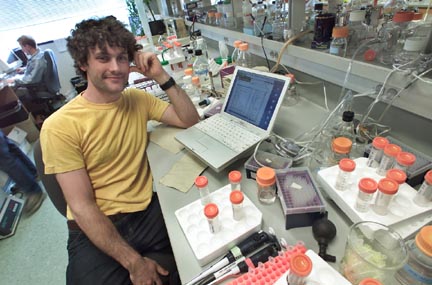 Justin Fay of the Life Sciences Division studied DNA variations across entire genomes of fruit flies and found evidence that natural selection drives mutations at the molecular level. |
Fay and his colleagues reconciled the contradictions by comparing the composite pattern from a large number of genes across the genomes of different fruit fly species rather than single genes. They also took the important step of discarding “deleterious” polymorphisms — mutations that negatively affect an organism and would eventually be eliminated from populations by natural selection.
“The effects of positive selection can be obscured by deleterious mutations that inflate the A/S ratio of polymorphism but not divergence,” explains Fay. “Removal of the deleterious changes allowed us to make a clear comparison between neutral and adaptive changes.”
For their polymorphism data, Fay and his colleagues focused on “common frequency mutations,” which they defined as those found in more than 12.5 percent of their population samples. Divergence data was obtained by comparing a randomly chosen DNA sequence of D. melanogaster with that of D. simulans or, if unavailable, that of D. mauritana, or D. sechilla.
“In going from gene studies to genomic studies, we found a substantial amount of positive selection taking place in protein evolution,” Fay says. “Most neutral theory supporters have suspected that this positive selection was happening, but they required a high standard of evidence to prove it. We’ve provided them with that evidence.”
The next step, according to Fay, is to examine the DNA sequences that do not code for proteins. In the human genome, for example, only about one percent of the DNA sequence actually carries instructions for making proteins. The remainder includes sequences that regulate the expression of genes (turns them on or off). Little has been done to determine the role mutations in these sequences may play in evolution. Fay is now part of a collaboration in the laboratory of Life Sciences Division’s Michael Eisen that is investigating the evolution of complex phenotypes in different species of yeasts.
“Maybe phenotype variations in organisms arise as a result of changes in gene expression,” he speculates. “Right now we only have a few examples of molecular changes that have been responsible for changes in a phenotype, but this area hasn’t really been explored, and there’s a lot of potential for new findings.”
By Ron Kolb
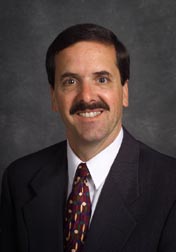 |
Laboratory Director Charles V. Shank announced this week that Reid A. Edwards, Berkeley Lab’s manager of government and community relations and an employee here since 1984, will manage the Public Affairs Department, which includes Communications, Government Relations, Community Relations, and the Center for Science and Engineering Education (CSEE).
These units were combined into the new department last summer under the management of David McGraw, who assumed the acting director’s role while continuing to serve as division director for Environment, Health and Safety.
“Reid’s unique combination of government experience, community service, and laboratory knowledge makes him a particularly suitable leader for this important area,” said Shank.
In making the appointment, Shank cited Edwards’ current service with both the Oakland and Berkeley Chambers of Commerce, the latter for which he serves as chairman. He is also a member of the Alameda County Economic Development Advisory Board, the Oakland Airport Fly Oakland Forum, and the Port of Oakland Business Advisory Forum.
Edwards first came to Berkeley Lab as a government relations officer in the Office of Planning and Development, where he also handled planning and logistics for high-level visitors to the Lab. He also managed special events and was the first director for the CSEE.
Since 1992, he has managed the Lab’s state and federal government relations programs, including official interactions with agencies, members of Congress and their staffs, and other elected officials. Berkeley Lab’s first organized local community relations program was formed under his direction.
“I am honored to have been chosen for this position,” Edwards said. “I’m looking forward to working with all of my colleagues throughout the Lab. My goal is to maintain a public affairs program that equals the stature of our outstanding science and ensures that we will be able to continue our research at those levels.”
Before coming to Berkeley, Edwards spent seven years in Washington, D.C., first as legislative assistant to Congressman George Miller, and then as special assistant to the executive director for the Transportation Institute. He earned a B.A. degree from of the University of California at Santa Barbara.
During his tenure at Berkeley Lab, Edwards has been involved in a variety of institutional planning efforts, including the Strategic Task Force on National Needs (1992-1993), the Transportation Systems Management Committee (1987-1990), the Communications Task Force (1994-1995), and the Laboratory Open Houses of 1995, 1997 and 2000.
Shank singled out McGraw for his role in managing the transition of units in an integrated Public Affairs program. “Through David’s leadership, Berkeley Lab has set a positive direction for enhanced public and community relations in the years to come,” he said. “I appreciate his contributions.”
By Dan Krotz
It took three fumigations spanning three months to rid the Hart Senate Office Building of anthrax after a single contaminated letter was sent to Senator Tom Daschle last October.
Although the epicenter of the $14 million cleanup was Daschle’s office, the nine-story building was sealed after traces of anthrax were found in other rooms. No one knows precisely how the aerosolized spores drifted from the envelope to the far corners of the building, but Berkeley Lab researchers are zeroing in on an understanding.
“We’ve always included aerosol behavior in our modeling and experimental work, but the seed crystal was what happened in the Hart Building,” says Richard Sextro of the Indoor Environment Department in the Environmental Energy Technologies Division. “It became very clear that one of the big unknowns is what happens after you open the envelope. Where does the anthrax go?”
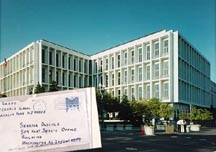 An anthrax contaminated letter sent to Senator Tom Daschle last fall closed the Hart Senate Office Building in Washington for several months. Berkeley Lab researchers have developed a model for studying the dispersal of anthrax spores that may eventually be used to guide decontamination efforts in such situations. |
The indoor anthrax model developed by Sextro and colleagues David Lorenzetti, Tracy Thatcher and Mike Sohn has its origins in the Department of Energy’s Chemical and Biological National Security Program, initiated in 1997. The program initially included Lawrence Livermore and Los Alamos’ work on outdoor modeling of biological and chemical attacks. But because Berkeley Lab’s Indoor Environment Department has one of the nation’s most comprehensive indoor air programs, Joan Daisey (the late head of the department) successfully pitched DOE in 1998 for funding to explore chemical and biological agent dispersion in buildings. A fourth DOE lab, Argonne, rounds out the program by modeling subway contamination.
Sextro and his colleagues have developed a model with a singular purpose: track the fate of airborne anthrax spores and use these simulations to estimate exposures. Their rationale is based on the unnerving fact that one gram of anthrax contains ten million, million spores, and only 10,000 spores are needed to spur a lethal case of inhalation anthrax. This also means nearly every spore counts, so the model has to be robust enough to depict anthrax dispersal in considerable detail.
To start, the team used information obtained from Indoor Environment Department experiments that studied aerosol transport and deposition in both rooms and ducts. In addition, a multizone building airflow model developed in part by Berkeley Lab scientists was used to simulate the room-to-room airflows that can potentially transport anthrax spores between rooms.
Combined, the two models paint a rough picture of what happens when an anthrax-laden letter is opened. For example, at between two and four microns in size, anthrax is a relatively large aerosol, so the models reflect that it is more susceptible to gravitational settling than smaller particles. In other words, more of a given amount of anthrax settles on tabletops and carpets than the same amount of a smaller combustion-produced aerosol, which is more likely to adhere to walls and ceilings. The models also predict the amount of aerosol that leaks through a building’s shell and accumulates in air ducts.
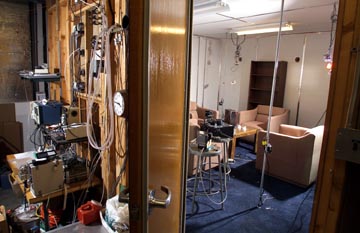 Aerosol research conducted at this dispersion testing facility in Building 63 was used to help develop the indoor anthrax model. Photo by Robert Couto. |
But most airflow models do not account for the activities of people. What happens when someone steps in anthrax that’s settled on the floor and tracks it from room to room? Or resuspends it into the air by simply walking on the floor? To explore this poorly understood component of anthrax dispersion, the modeling team incorporated terms that describe foot traffic’s influence on deposition and suspension. Delving deeper, they subdivided surfaces into two types: accessible areas, surfaces on which people can walk and unwittingly disturb deposited anthrax, and inaccessible areas comprised of hard-to-get-to surfaces like corners and behind desks; once anthrax settles in such places, it typically isn’t tracked or re-suspended. These additional variables enable the model to more fully map the chain of events that affect anthrax dispersal.
“This pushes us, conceptually, into a new area of knowing what happens to particles on accessible surfaces where they can be re-suspended or tracked,” Sextro says. “This is important, because by examining anthrax dispersal in as complete a picture as possible, we determine where we need to focus our research.”
So far, the model has been unleashed in a hypothetical, computer-generated, 190-square-meter office floor subdivided into a main hallway surrounded by six offices, each occupied by one person. A letter carrying one gram of anthrax is opened in one room. Some anthrax remains in the envelope, some settles on the floor, and some disperses into the air. Several scenarios are played out. In one, everyone remains in their office and the HVAC system is the sole means of dispersal. In more complex scenarios, people move from room to room and track, resuspend, and redeposit anthrax throughout the office floor. Disturbingly, in even the simple scenario, everyone exceeds or comes close to receiving a lethal dose.
Although the model is still under development and is primarily a research tool, Sextro believes it can eventually be used to map real-world exposure cases.
“It’s very important to know how much anthrax is in the HVAC system, on the floor, and on the backside of ceiling tiles,” Sextro says. “In addition to the important task of estimating potential exposures, and — ultimately — how to avoid high exposures, the model can help focus decontamination efforts by determining where anthrax accumulates.”
The White House Office of Management and Budget (OMB) has announced its criteria for evaluating basic research supported by the federal government. At a meeting at the National Academy of Sciences in Washington on Feb. 27, OMB officials said that basic research will be measured by three criteria: the quality of the research, its relevance to the funding agency, and its performance based on defined goals and measures.
OMB officials added that research programs will be reviewed every three to five years, and that each federal agency should set appropriate standards against which its overall research performance can be assessed annually. These measures have yet to be set, so it remains uncertain as to how they will future federal R&D budgets.
OMB director Mitch Daniels stated his strong commitment to these new criteria for basic science.
“Even in this most speculative area of government investment, our decisions cannot be immune from standards and quality,” he said.
Coinciding with the White House’s announcement of criteria for evaluating basic research supported by the federal government, a top advisor for DOE’s Basic Energy Sciences Advisory Committee (BESAC) cautioned that DOE’s Office of Science (SC) must develop benchmarks for measuring progress in basic research without crippling the innovation that is the hallmark of U.S. scientific inquiry.
John Stringer, who chaired BESAC’s subpanel on SC performance measurement, presented his panel’s findings and recommendations at the BESAC meeting in Gaithersburg, Maryland on Feb. 25-26. The conclusion: SC should follow the general method of assessing program performance that the office has used in the past.
“The use of peer review is the most appropriate way to gauge the accomplishments of basic science programs,” Stringer said. “You must make sure peer review is done so something identifiable comes out of it. You have to be able to use the information from peer review in the budget process.”
Like other federal agencies that support scientific research, SC has been working with the OMB to develop criteria for determining the progress of basic science programs.
“The importance of these criteria can’t be overstated,” Stringer said. “However, we want to make sure this is done well, and make sure it doesn’t harm American science programs.”
Stringer’s subpanel argued that most basic research efforts are better assessed in qualitative rather than quantitative terms, which may pose challenges for those who would measure the progress of such efforts. However, Stringer did warn SC’s national laboratory scientists to accept the idea that their research will eventually be appraised.
“There’s no use hoping this will go away,” he said. “We have to be able to tell taxpayers what they’re getting for their money.” — Lynn Yarris
By Ron Kolb
 |
Berkeley Lab has been selected as one of several Bay Area locations where portions of the upcoming movie The Incredible Hulk will be filmed.
According to a contract signed this week by the Laboratory and the U.S. Department of Energy with Universal Studios, the film’s crew will be shooting scenes in and around the Advanced Light Source on April 20 and 22. The ALS will be in its annual shut-down period during that time.
The movie will be adapted from the Marvel Comics’ story about a scientist whose exposure to gamma radiation from space transforms him during moments of stress and anger into the now-familiar muscular green superhero. The film will be directed by Ang Lee, whose Crouching Tiger, Hidden Dragon won the 2001 Oscar for best foreign language film. Lee also directed other acclaimed films such as Sense and Sensibility and Ice Storm.
Hulk will star Eric Bana (Black Hawk Down) as scientist Bruce Banner and Jennifer Connelly (A Beautiful Mind) as his love interest. The Hulk himself will be a computer-generated image created by the special effects wizards of Industrial Light and Magic of Marin County.
Lee and his production staff were said to be fascinated by the intricacies of the ALS interior and the Lab’s breathtaking views of the Bay Area. They will also shoot scenes in San Francisco during their April visit.
The Incredible Hulk is scheduled for a summer 2003 release.
The agreement with the film company ensures that no facilities or lab environment will be altered or damaged during the course of the filming, and no research will be disrupted. Berkeley Lab will be reimbursed for all costs incurred in the management and control of the project.
A specific filming schedule has not been set for the two-day shoot. Equipment and crew are scheduled to arrive on Friday evening, April 19, in order to minimize disruption of traffic and parking. Normal off-hours employee access to the Lab may be restricted for the duration of that weekend.
Peter Nugent, an astrophysicist in NERSC’s Scientific Computing Group who made news last year as co-discoverer of the oldest supernova ever found, has been asked to join the Hubble Space Telescope Users Committee. This international panel of 12 scientists advise the Space Telescope Science Institute and NASA on the normal operations of the Hubble Space Telescope and make recommendations for changes and improvements.
Nugent joined NERSC last year after four years as a postdoc in the Physics Division. He is the recepient of a Hubble Space Telescope grant and a NASA Space Astrophysics grant. He previously worked with Saul Perlmutter's Supernova Cosmology Project. — Jon Bashor
Raymond Orbach, who has guided the University of California’s Riverside campus as chancellor for more than nine years, was confirmed by the U.S. Senate on March 4 as the new Director of the Department of Energy's Office of Science.
Orbach, 67, was nominated by President Bush last December.
The Office of Science exercises oversight over national laboratories, funds university research and helps set the U.S. scientific agenda.
Upon hearing of the nomination in December, Lab Director Charles Shank praised Orbach as “a widely respected physicist,” who “will bring a unique combination of both scientist and leader to the job.”
A theoretical physicist and professor, Orbach was appointed chancellor at UC Riverside in March 1992. He joined UCR following a 29-year career at UCLA.
“The strength of the United States economy and defense is dependent in large part on the successful stewardship of science at the Office of Science and her sister agencies,” Orbach said during the Senate confirmation hearings.
Orbach will replace interim director James F. Decker, who has served since Jan. 20.
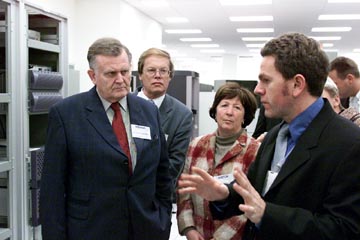 |
Twenty representatives of government, academia and industry from the German state of Baden-Wuerttemberg, led by state governor Erwin Teufel (left), visited NERSC’s computing facility during a recent tour of California. NERSC’s Erich Strohmaier (right) provided an overview and computer room tour in German for the visitors.
The group specifically chose to visit NERSC in light of discussions regarding the best way to rebuild the supercomputing center at the University of Stuttgart. Because of the size, power and cooling demands of new generations of supercomputers, the most cost-effective approach for NERSC was to build a new computing facility, rather than retrofitting an existing one. Photo by Robert Couto
Director Charles Shank has issued the call for proposals for the FY 2001 Laboratory Directed Research and Development (LDRD) program, which provides support for projects in forefront areas of science that can enrich Berkeley Lab’s R&D capabilities and achievements.
Multi-investigator and multidivisional initiatives that address problems of scale are especially encouraged. All projects should have a clearly-stated problem (e.g., DOE mission or addressing a national need), coherent objectives, and a well-considered plan for leadership, organization and budget.
The call for proposals has been distributed to division directors and business managers. Principal investigators must submit proposals to division directors by April 19.
After an internal divisional review and evaluation, division directors will forward the proposals to the Director’s office. They will then present the proposals from their respective divisions to review committees comprised of the Director, deputy directors, associate laboratory director, and other division directors. The Director will make the final decisions.
The complete call, schedule, guidance, and forms are available for downloading off the Lab home page under the heading Publications and then LDRD (or directly at http://www.lbl.gov/Publications/LDRD/).
Published twice a month by the Communications Department for the employees and retirees of Ernest Orlando Lawrence Berkeley National Laboratory. Ron Kolb, Communications Department head.
EDITOR: Monica Friedlander, (510) 495-2248, msfriedlander@lbl.gov
STAFF WRITERS: Lisa Gonzales, 486-4698; Dan Krotz, 486-4109, Paul Preuss, 486-6249; Lynn Yarris, 486-5375
CONTRIBUTING WRITERS: Jon Bashor, X5849; Allan Chen, X4210
FLEA MARKET / CALENDAR: (510) 486-5771
fleamarket@lbl.gov / currents_calendar@lbl.gov
Lawrence Berkeley National Laboratory
One Cyclotron Road, MS 65A
Berkeley CA 94720
Tel: (510) 486-5771 Fax: (510) 486-6641
Berkeley Lab is managed by the University of California for the U.S. Department of Energy.
Thanks to a new program implemented last year, some Lab employees will be granted a one-time service credit allocation for past employment, which increases the value of their retirement benefits. To qualify, employees must have had previous temporary employment in an eligible staff and/or academic position for more than six consecutive months and been employed in an eligible staff appointment during the 2001 calendar year.
Employees who received a letter last summer informing them of their automatic credit allocation and who do not wish to appeal, need not take any further action. The credit has already been posted.
Those who did not receive a letter but believe they are entitled to this credit may request the allocation by submitting a UBEN 171 Request Form accompanied by supporting documents. The form may be obtained from the Benefits Office at X7873.
The deadline for submittig a completed request is July 31, 2002. Please note that in order to ensure that Benefits and your HR Center are able to help you secure the necessary documents by the July deadline, you need to contact HR/Benefits no later than April 30.
The previous temporary employment may have been in either a staff or academic appointment. This is a correction to the original information published in the program brochure.
A new program for current academic appointees will be announced soon. If you are currently in a staff position, howver, and wish to request credit, do not wait for the new program.
Information brown bag on March 14
If you would like to learn more about the One-time Service Credit Allocation Program, have questions about your eligibility, or would like help submitting your request to UCOP, you are invited to attend a brown bag seminar on Thursday, March 14 from 10 to 11:30 a.m. in Building 2, Room 100B.
For more information, contact Angela Dawn, service credit specialist in the HR/Benefits Department, at X7873, Adawn@lbl.gov.
The U.S. Department of Energy has granted a one-year extension to Berkeley Lab’s Employee Referral Incentive Program (ERIP), initiated one year ago as a pilot program to enhance recruitment efforts at the Lab. The program awards employees $1,000 for job referrals that lead to a successful hire. The extension will run through Jan. 31, 2003.
DOE also approved the expansion of ERIP to include referrals for postdoctoral and visiting postdoctoral fellows, who represent a significant segment of the workforce here.
During ERIP’s first year, the program received 407 referrals that led to the hiring of 34 people. Positions filled as a result of these efforts include administrative assistants and administrative specialists, budget analysts, financial analysts, scientific engineering associates, computer systems engineers, research associates, health/safety technicians, bus and truck drivers, and others.
To make a referral, complete an ERIP referral form and send it along with the prospective employee’s resume to the ERIP coordinator, either by e-mail (employeereferral@lbl.gov) or by Lab mail (MS 937-600.) Please note that submitting the referral directly to the hiring supervisor does not guarantee award eligibility. Referrals must also be submitted in a timely manner. Late submittals, or referrals made after the job interview has taken place or after an offer has been extended will not qualify for the award.
For more information see http://www.lbl.gov/Workplace/HumanResources/ERIP/index_erip.html.
What is the amount of the award?
It is $1,000, paid as a lump sum.
What job openings qualify?
Most positions posted on LBNL’s Current Job Openings, as well as doctoral fellow positions as of Feb. 1. Exceptions include openings for student assistants, GSRAs, trainees, interns, and limited positions.
Who can make a referral?
All full- and part-time Lab employees can make a referral. Not eligible are contractors, participating guests, members of the senior management group, recruiters in HR, managers and supervisors for positions in their own reporting chain, HR Center employees for positions within their center’s assigned customer base, and employees who represent Berkeley Lab at job fairs or recruitment events when the referral would result from attendance at these functions.
Who can be referred?
Persons referred through the program may not be employed by the Lab. Former employees may be referred if they left the Lab at least one year ago.
Ineligible referrals include current contract labor or participating guests; individuals providing services through personal service or consultant agreements; persons whose resume is already on file or who are under active consideration; and persons referred by an employment agency or search firm which remains entitled to a fee.
Can I refer a person more than once?
If you made a referral more than six months ago and your referral has not been hired or is not under active consideration, contact the ERIP coordinator. You may be able to refer that person again provided the resume is no longer active.
When will I receive the award?
The award payment will be made within one month from the date the new hire reports to work.
Am I eligible for more than one award?
There is no limit to the number of referrals you can make or awards or can receive.
Starting this week, Berkeley Lab’s offsite shuttle bus routes and schedules underwent some significant changes. As indicated on this map, the primary route to downtown (dotted line) will be along Hearst Avenue. This shuttle runs every 10 minutes from 6:30 a.m. to 5:40 p.m. and every 20 minute from 5:50 to 6:50 p.m. Buses along the more circuitous route across Gayley Road run every 30 minutes, leaving Building 65 at quarter to and quarter after the hour from 6:45 a.m. to 4:15 p.m.
The shuttle van to Building 937 was eliminated, but a new stop was added to the Hearst route – just one block away from the 937 entrance. For more information see the bus services web site at http://www.lbl.gov/Workplace/Facilities/SiteSvcs/indexbus.htm.
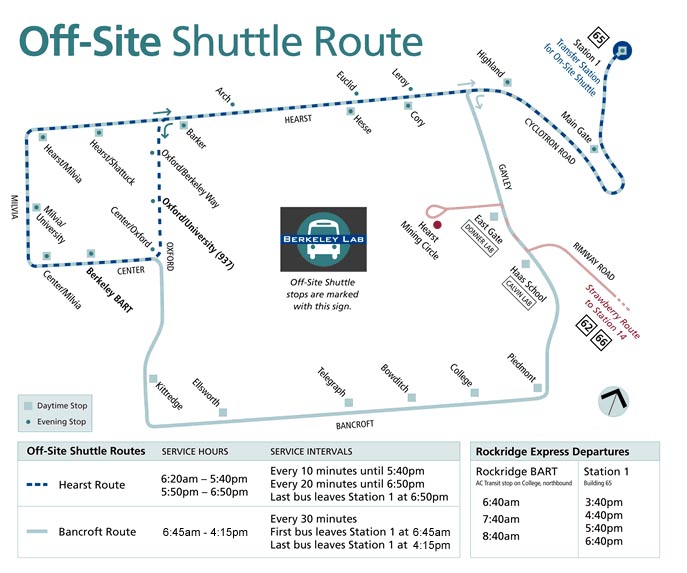 |
By Monica Friedlander
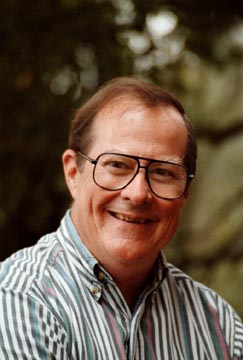 |
Renowned seismologist Thomas Vincent McEvilly of the Lab’s Earth Sciences Division and a professor emeritus of earth and planetary sciences at UC Berkeley died on Feb. 22 in St. Louis after an eight-month battle with cancer. He was 67.
A highly respected expert on California earthquake faults, McEvilly headed Berkeley Lab’s Earth Sciences Division from 1982 to 1993. He was best known for a 15-year project with U.S. Geological Survey to study the San Andreas fault in Parkfield in hopes of developing means of predicting large earthquakes.
“Tom's enthusiasm for world-class experimental science was admirable,” said Sally Benson, now deputy director for Operations at Berkeley Lab and a former colleague of McEvilly’s in Earth Sciences. “It was wonderful to see someone so excited about his work, and it rubbed off on all of us.”
Benson credited McEvilly with “laying the seeds” as division director for what eventually became the environmental remedial research program, the isotope geochemistry program, and the oil and gas production research program.
Born in East St. Louis, Ill., McEvilly earned his degrees in geophysical engineering (1956) and his Ph.D. in geophysics (1964) from St. Louis University. He joined UC Berkeley in 1964 and continued his work in earthquake seismology, specializing in measurements and instrumentation. He retired from UC in 1994 but continued his earthquake-related research until his death.
“He was incredibly well-respected by everyone in Earth Sciences for his research, insights, mentoring, and friendship to all, whether graduate students or senior scientists,” said Bo Bodvarsson, the current director of Earth Sciences. “There is a very large void in ESD now, and he will be truly missed by everyone.”
McEvilly first teamed up with the USGS to study the earthquake site in Parkfield — a tiny ranching community 165 miles south of San Francisco — shortly after a major quake struck the area in 1966. The team installed sophisticated monitoring devices deep in the earth’s crust, including deep bore-hole sensors and recording systems.
Their research yielded valuable information about the day-to-day movement of the fault based on the detection of microquakes at the site.
Along with ESD colleague Robert Nadeau, McEvilly coauthored a paper in the July 30, 1999 issue of Science, in which they analyzed high-resolution data collected in the Parkfield region since 1987. They found that clusters of identically repeating tiny earthquakes on a stretch of the San Andreas Fault can be timed to reveal the rate at which the two great tectonic plates are grinding past each other deep within the earth — information they hoped could lead to new ways to monitor the buildup of fault strain associated with larger quakes.
McEvilly also helped set up a high-frequency bore-hole seismic network along the Hayward Fault, which led to the finding that the northern Hayward Fault — stretching from Berkeley north to Point Pinole — slips deep underground to relieve strain and is less likely to generate severe quakes than previously expected. The paper, coauthored by scientists at the Lab and UC Berkeley, was published in the Aug. 18 issue of Science.
In 1984, he helped found and was the first president of Incorporated Research Institutions for Seismology, an NSF-sponsored consortium of nearly 100 U.S. universities and affiliates devoted to development, deployment and support of modern digital seismic instrumentation. It currently operates a global seismographic network of 126 stations and supplies seismological data to scientists around the earth.
McEvilly was a fellow of the American Geophysical Union and the American Association for the Advancement of Science, an honorary member of the Seismological Society of America, and a member of the Society of Exploration Geophysicists, the Royal Astronomical Society, and Phi Beta Kappa.
He is survived by his wife of 31 years, Dottie Hopfinger McEvilly; children Mary Scott, Susan McEvilly, Ann Dodson, Joe McEvilly, Adrian McEvilly, and Steve McEvilly; sister Dorothy Hennessy, brothers Robert and Mike McEvilly; and nine grandchildren. He was buried in Belleville, Ill on March 2. A memorial service will be held in Berkeley at a later date.
The UC Berkeley Department of Earth and Planetary Science plans to create a graduate student seismology fellowship in McEvilly’s honor. Donations may be sent to the department at 307 McCone Hall, University of California, Berkeley, CA 94720-4767.
Hundreds of cyclists, pedestrians, and people in wheelchairs eagerly awaited to be among the first to cross the newly-completed bicycle/ pedestrian bridge spanning I-80 near the foot of University Avenue. The bridge, officially inaugurated last Wednesday, provides access between the residential and business districts on the east side of the freeway and the Berkeley waterfront.
The overcrossing consists of a steel arch bridge with approach ramps and a touchdown plaza on each side. The gentle 5% slope allows easy access for wheelchairs, cyclists, strollers, and skaters.
The $4.4 million project was funded through federal, state and local funds. City manager Weldon Rucker and various elected and project officials took part in the official opening ceremony on Feb. 27. Photo by Roy Kaltschmidt
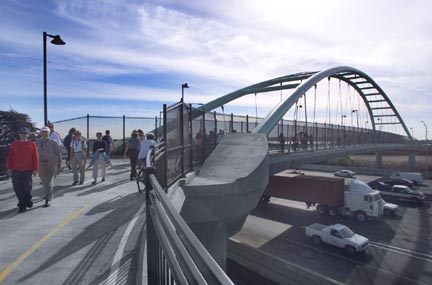
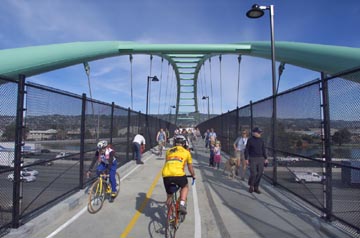 |
If you would like to learn more about the One-time Service Credit Allocation Program (see page 4), have questions about your eligibility, or need help submitting your request, you are invited to attend a brown bag seminar on Thursday, March 14 from 10 to 11:30 a.m. in Building 2, Room 100B. The deadline for submitting the request and documentation is July 31.
For more information about the program or the brown bag session, contact Angela Dawn, service credit specialist in the HR/Benefits Department at X7873, .
Two timely topics will be addressed during the next meeting of the Mac Users Group, to be held on Wednesday, March 13. The first part of the meeting will be devoted to Nat Stoddard’s presentation of “The Top Ten Mac Issues at the Help Desk.” Stoddard will be followed by James Buszard-Welcher, who will present “Mac OS 10: A Look from the UNIX perspective.” The session will be held from 11 a.m. to 12:30 p.m. in Building 90-3148.
Current or prospective users of Windows XP are invited to attend a free minicourse on Windows XP security, to be held from 9:30 to 11:30 a.m. on Wednesday, March 13 in the Building 50 auditorium. The course will be taught by Eugene Schultz, author of “Windows NT/2000 Network Security.”
To preenroll send an e-mail to cp-seminar@lbl.gov and eeschultz@lbl. gov and include your name and employee number.
A presentation and Q&A session will be held on Thursday, March 28, to provide employees with current information about the CalPERS Long-Term Care (LTC) plan. The next enrollment period for LTC begins on April 1 and runs until June 30. The brown bag session will be held from 10 to 11:30 a.m. in Building 2-100B. To enroll send an e-mail to benefits@lbl.gov by March 22.
Long Term Care, which is not part of the regular UC benefits package provided to Lab employees, refers to the extended care not covered by disability, health insurance, or Medicare. Medicare only handles skilled care (provided by a doctor or nurse), and MediCal covers long-term care after you have exhausted virtually all of your own assets. The LTC plan provides funds to pay for assistance at home or care in a nursing home, assisted living facility or adult day care center when dealing with chronic illness, injury or the frailties of old age.
The CalPERS program provides comprehensive and affordable coverage with a variety of options, and is tax qualified. All Lab employees, retirees, spouses, parents, and parents-in-law and siblings (age 18+) are eligible. Application packets will be available at the seminar or may ordered by calling 1-800-758-7070 or via the web at http://wwwrs.ca.gov/longtermcare/.
Materials scientist Gabor Somorjai will speak about “Surfaces: Favorite Media of Evolution and New Technologies” on Wednesday, March 20 at 1 p.m. in the Building 66 conference room (Room 316). His talk is part of the “Science for Support Staff” lecture series, presented by researchers in the Materials Sciences Division for the benefit of those who don’t have a science background but are interested in the science being conducted at Berkeley Lab.
The series focuses on research in the materials sciences and is presented in laymen’s terms. All employees are welcome to attend.
Somorjai’s talk will address modern “surface” technologies, such as the catalytic converter in your car, the microelectronic circuit in your computer, and the optical fiber for your telephone. He will discuss the properties of surfaces and how they control familiar phenomena: the slipperiness of ice, the detergent action of cleaners, and the stretching of a rubber band.
For more information about this lecture or the series, contact Sally Nasman at X4714.
The second presentation offered by Berkeley Lab in observance of national Black History Month will feature famed civil rights attorney John Burris from Oakland, who will speak about “Racial Profiling Before and After September 11.” The presentation will be held on Friday, March 8 at noon in the Building 50 auditorium. Everyone is invited to attend. Students from local area schools will also be present.
The Black History Month activities are being organized by the Workforce Diversity Office.
Judges are sought by Franklin Middle School in Vallejo for its science fair on Wednesday, March 13. By participating in the fair, scientists can support and boost the partnership the Lab has established with the Vallejo City Unified School District. For information contact Don Hubbard at X5060.
Preregistration for this summer’s Science Exploration Camp (SEC) run by Berkeley Lab is open through the end of March. The camp provides a mix of recreational and science-oriented activities for school-age children of Lab employees. The camp will run from July 15 through Aug. 23, with each of the six sessions featuring a different theme:
1. Math and Computers (July 15-19)
2. Environment and Earth Sciences (July 22-26)
3. Microscopy (July 29 - Aug. 2)
4. Health and Medicine (Aug. 5-9)
5. Integrated Science Aug. (12-16)
6. Energy (Aug. 19-23)
The cost for each one week session is $185 during the preregistration period and $200 a week after March 31.
Paid positions are also available for camp staff. Current openings include a half-time director, a full-time assistant director, and full- and part-time counselors.
For more information, registration forms, and job descriptions, see the SEC website at http://sciencecamp.lbl.gov.
BLACK HISTORY MONTH PRESENTS: JOHN BURRIS
Noon, Bldg. 50 auditorium
WINDOWS XP MINICOURSE
9:30 – 11:30 a.m., Bldg. 50 auditorium
MAC USERS MEETING
11 – 12:30, Bldg. 90-3148
ONE-TIME SERVICE ALLOCATION BROWN BAG
10 – 11:30, Bldg. 2-100B
SCIENCE FOR SUPPORT STAFF PRESENTATION
Gabor Samorjai, 1 p.m., Bldg. 66 auditorium
COUNTERTERRORISM AND SCIENCE & TECHNOLOGY
Randall Murch, FBI Laboratory 12 – 1:30 p.m., Bldg. 50 auditorium
Send us your announcements
Announcements for the General Calendar and Bulletin Board page may be sent to MSFriedlander@lbl.gov. Seminar & Lectures items may be mailed to currents_ calendar@lbl.gov. You may also fax items to X6641 or mail them to Bldg. 65B. The deadline for the March 22 issue is 5 p.m. Monday, March 18.
NERSC DIVISION SCIENTIFIC COMPUTING SEMINAR
Computing in the General Science Divisions at LBNL
Speaker: Stewart Loken, Physics Division
1:00 p.m., Bldg. 50F, Room 1647
DEPARTMENT OF PHYSICS OPPENHEIMER LECTURE
Emergent Quantum Certainty
Speaker: Robert B. Laughlin, Stanford University
5:45 p.m., Wheeler Hall
LIFE SCIENCES DIVISION SEMINAR
Integrated Cryo-Electron Microscopy
Speaker: Bridget Carragher, the Scripps Research Institute
4:00 p.m., Bldg. 66 auditorium
ENVIRONMENTAL ENERGY TECHNOLOGIES DIVISION SEMINAR
Fast Parts and Rapid Prototypes: Effective Design and Engineering with
DesignWorks
Speaker: Ken P. Chow, Engineering Division
Noon, Bldg. 90, Room 3148
CENTER FOR BEAM PHYSICS SEMINAR SERIES
Supercomputing Applications in Beam Dynamics
Speaker: Andreas Kabel, SLAC
10:30 a.m., Bldg. 71, Room 264; Refreshments at 10:20 a.m.
ENVIRONMENTAL ENERGY TECHNOLOGIES DIVISION SEMINAR
Source Contribution of Indoor Activities to Human PM Exposure
Speaker: Andrea Rose Ferro, Stanford University
Noon, Bldg. 90, Room 3148
NERSC DIVISION SCIENTIFIC COMPUTING SEMINAR
Calculating the Large Scale Structure of the Universe
Speaker: Martin White, UC Berkeley
1:00 p.m., Perseverance Hall
DEPARTMENT OF PHYSICS COLLOQUIUM
Dynamics of Planetary Rings and Extrasolar Planets
Speaker: Eugene Chiang, UC Berkeley
4:30 p.m., 1 Le Conte Hall
BIOSCIENCES DISTINGUISHED LECTURE
Cell Cycle Control in Eukaryotes
Speaker: Stephen J. Elledge, Baylor College of Medicine
4:00 p.m., Bldg. 66 auditorium
ENVIRONMENTAL ENERGY TECHNOLOGIES DIVISION SEMINAR
UC Merced Energy Planning: Early 2002 Status Update
Speaker: Karl Brown, California Institute for Energy Efficiency
Noon, Bldg. 90, Room 3148
PHYSICS DIVISION RESEARCH PROGRESS MEETING
Quaero: Making HEP Data Publicly Available
Speaker: Bruce Knuteson, University of Chicago
4:00 p.m., Bldg. 50A, Room 5132
NUCLEAR SCIENCE DIVISION COLLOQUIA
From the Early to the Present Universe: From the Big Bang to Compact Stars
Speaker: Daniel Boyanovsky,University of Pittsburgh
11:00 a.m., Bldg. 50 auditorium
ENVIRONMENTAL ENERGY TECHNOLOGIES DIVISION SEMINAR
Dust in the Indoor Environment: Physical and Chemical Changes Due to Hot
Surface Contact
Speaker: Olav Bjorseth, Norwegian University of Science and Technology
Noon, Bldg. 90, Room 3075
LIFE SCIENCES DIVISION SEMINAR
Imprinting and Epigenetic Reprogramming in Mammalian Development
Speaker: Wolf Reik, The Babraham Institute, UK
4:00 p.m., Bldg. 84, Room 318
ENVIRONMENTAL ENERGY TECHNOLOGIES DIVISION VIDEO SEMINAR
Video tape viewing of the Feb. 15, 2002 EETD seminar: Fuel Cells vs. Batteries:
Issues and Challenges Facing the Development of Electrochemical Power
Systems for Transportation Applications
Speakers: Philip Ross, Materials Sciences Division, with John Newman,
Kathryn Striebel, John Kerr, Elton Cairns, Robert Kostecki, and Frank
McLarnon, of EETD’s Advanced Energy Technologies Department.
Noon, Bldg. 90, Room 3148
CENTER FOR BEAM PHYSICS SEMINAR SERIES
A Compact Hadron Therapy Accelerator
Speaker: Bill Chu, Life Sciences Division
10:30 a.m., Bldg. 71, Room 264; Refreshments at 10:20 a.m.
‘98 HONDA ACCORD coupe EX, blk on blk, ac, sunrf, upgraded cd/stereo/ speakers, recently serviced, new tires, very clean, 55K mi, $14,000/bo, Susan, X5429, 964-0007
‘97 FORD EXPLORER, 4 wd, control trak, XLT, 87K mi, pwr steer/win/locks, cruise, tilt wheel, dual pwr seats, ac, am/fm/cass/cd, leather, tow pkge, class II trailer hitch+electric trailer brakes, rear ac/heat/radio controls, fog lights, anti-theft device, dual air bags, privacy glass, abs, roof rack, off-rd tires, must sell asap, $14,800/bo, Randy, X7026, (925) 228-7427
‘93 VOLKSWAGEN GOLF III, 4 dr, white, 95K mi, at, ac, am/fm/cass, pwr sunrf, good cond, recent smog check, $4,400/bo, Alex, X8628, (925) 943-3058
‘89 HONDA ACCORD LXI, 4 dr sedan, blk, ac, sunrf, cruise, am/fm/cass, pwr win/locks/mirrors, very clean, 134K mi, $3,500, Linda, 236-6331
‘78 MUSTANG II, V6. under 55K orig mi, 2dr, white w/ blue int, 1 owner, very well maintained, Kathy, (925) 855-9135 6-8 pm
‘72 240 Z, rebuilt eng runs, minor door dings on body, in storage for 4 yrs, 5 spd, $1,750/bo, Dan, X4240, (707) 747-1303
BATTERY for Ford Escort/ Mercury Tracer (65 AH), 1 yr old, used only 5 mo, $30, Joern, X2407, (925) 935-6310
BERKELEY, furn rms in 6 bdrm/2 bth "House of Scholars," $670-790/mo + 15% util, see housintscholar.home.mindspring.com, Anushka, 486-8153, housintscholar@mindspring.com.
BERKELEY, sm furn room w/ priv bth in home near Claremont, borders Parkland, walk to UC, overlooks garden patio, light cooking allowed, other tenants incl owners & UC faculty, mature researchers/ scholars & long-term visiting faculty pref, rent $500 (lower in exchange for house sitting), Jay, 848-4022
BERKELEY, spacious furn room in historic brown shingle, walk to pub trans, shops & campus, w&d, phone, TV, limited kitchen priv, single pref, avail now, $500/mo, Rob, 843 5987
EL CERRITO well furn room, prefer mature student or visiting scholar, desk, internet access, cable TV, priv phone line, w&d, walk to pub trans & shops, off street parking, quiet area, no smoking/pets/guest live-in, $600/mo + internet fee, $650 dep, roomrenting@hotmail.com
N. BERKELEY HILLS, 1 bdrm, 1 person garden apt w/ fireplace, off Grizzly Peak Blvd, 1 blk to pub trans, 3 mi to Lab, avail 3/15, $940/mo incl util & laundry, no smoking/pets, 1st+last+sec ($250), Barbara/Bill, 524-5780 8 am to 9 pm
FINNISH visiting scientist w/ 2 children (12 & 14 yrs old) seeks a place 7/1-7/19, pref near campus & pub trans, Kenzi, X6759, 236-1742
LAB EMPLOYEE seeks sm house/cottage/ duplex, 1-2 bdrm, Berkeley/Oakland, Loretta, X6068, lhhintz@lbl.gov
DIGITAL CAMERA Sony MVC-FD83, uses standard 3.5" floppy disk for recording, video mode, bag & 2 lithium-ion batteries & charger, like new, $220/bo, C.C. Lo, X2710, 235-3983
FREEZER, 16.1 cu ft upright, white, Wards HMG 4538-0, $90; Patton compact heater, MMH-65, $9, Ron, X4410, 276-8079
GRACO port-a-crib, good cond, $25; Graco baby walker w/ attached toys, hardly used, good cond, $15, Lisa, X5314, (925) 906-9786
KENMORE 25.2 cu ft, side-by-side freezer/refrige w/ ice maker & water filtration system, cream, 8 mo old, $990, Joern, X2407, (925) 935 6310
SIMMONS MAXIPEDIC twin long mattress, exc cond, dorm size, used 1 semester, matching boxspring incl, $199, in Albany, Philip, X7307, 558-8856
VIOLIN, size 3/4, $150; 2 deck chaise lounges w/ cushions/wheels, deck table/umbrella, $150; elec rice cooker, $15; portable heater, $10; desk w/ 2 drawers/2 files, $30; twin bed, complete set, $80; queen bed frame, $5; queen headboard w/ storage, $30; microwave stand w/ whls, $20; storage cabinet, $20; fish tank w/ pump & heater, $10; photos avail, Ming, X5616, 530-0462
Dog ITEM donations for Waggin’ Dog Rescue, need dog food, crates, leashes, food & water bowls, pet beds, blankets, Carol, X6651, 794-4076
WATER SKI BOARD, 2 singles, Ming, X5616, 530-0462
KIHEI, MAUI, 1 bdrm condo, across the street from Kam 2 beach (best beach on Maui), fully equipped, view the ocean/ Haleakela, $400 + 12% Hawaii hotel tax ($450/wk), Fred or Shar, 981-2073 days, 523-4150 eves
SANTORINI, GREECE, package for 2, suite, 5 nights, breakfast & dinner, gorgeous hotel, avail through 10/30, $790/bo, Barbara, 652-7044
S. LAKE TAHOE, spacious chalet in Tyrol area, close to Heavenly, fully furn, peek of lake from front porch, sleeps 8+, sunny deck, pool & spa in club house, close to casinos, attractions, $150/ day + $75 1-time cleaning fee, Angela, X7712, Pat/Maria, 724-9450
TAHOE KEYS at S. Lake Tahoe, 3 bdrm house, 2-1/2 bth, fenced yard, quiet, sunny, close to attractions, priv dock, great view, $175/ night, 2-night min, Bob, (925) 376-2211
LOST: sport sunglasses (bicyclist-type) w/ prescription insert, Addidas, navy blue w/ yellow trim, valuable & missed, Sherie, X5894
Ads are accepted only from LBNL employees, retirees, and onsite DOE personnel. Only items of your own personal property may be offered for sale.
Submissions must include name, affiliation, extension, and home phone number. Ads must be submitted in writing via e-mail (fleamarket@lbl.gov), fax (X6641), or delivered/mailed to Bldg. 65B.
Ads run one week only unless resubmitted, and are repeated only as space permits. They may not be retracted once submitted for publication.
The deadline for the March 22, 2002 issue is Thursday, March 14.